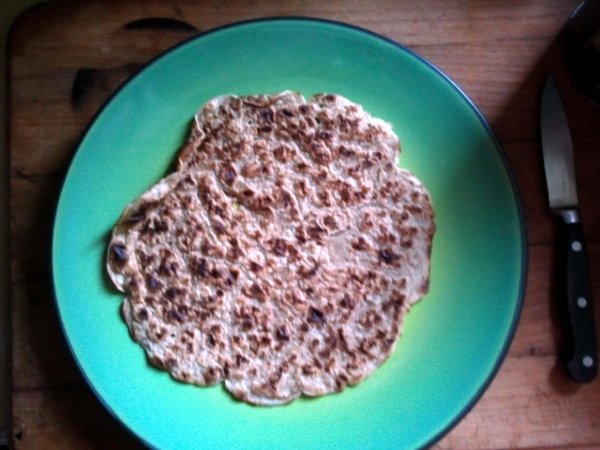Forbidden food
Throughout human history there has always been forbidden food – the fruit of the tree of knowledge in the Old Testament, the various dietary restrictions imposed upon devotees by religion (e.g. kosher, halal, etc.) and the like.
In addition to these there are other prohibitions imposed by other considerations, such as the cost of getting something to market. Other factors include whether something is (or is regarded as) a local speciality and is hence doesn’t travel – or not very far anyway. One such English local speciality is not available as far south as Bristol*, although it does travel north into Lancashire (it’s available in Sainsbury’s in Darwen by Blackburn. Ed.); and that’s the North Staffordshire oatcake.

According to Wikipedia, a North Staffordshire oatcake is a type of pancake made from oatmeal, flour and yeast. It’s cooked on a griddle or ‘baxton’. The oatcake is a local speciality in the North Staffordshire area of England. They are normally referred to as Staffordshire oatcakes or possibly Potteries oatcakes by non-locals, because they were made in this area. In and around Staffordshire and Cheshire they are often simply known as oatcakes.
North Staffordshire exiles are fortunate that they can now order this local delicacy online from such companies as Newcastle’s North Staffs Oatcakes Ltd and Biddulph’s Povey’s Oatcakes, to name but two.
As regards the location of oatcake shops in the Potteries and surrounding area, My Tunstall has helpfully provided an oatcake shops map. Earlier this year, a legendary oatcake shop, the Hole in the Wall closed due to a council compulsory purchase order. It was so called because the oatcakes were served to customers in the street via the front window and Stoke City Council should hang its head in shame at its destruction of the area’s heritage. Vic, my late stepfather, used to buy his oatcakes at the Hole in the Wall.
The furthest recorded oatcake shop from the banks of the Trent can be found in Auckland, New Zealand, where an expatriate Leek resident has set up business.
My oatcakes were bought from TJ Oatcakes & Sandwich Bar of 589 Leek Road, Hanley, ST1 3HD (map), just a short walk down the hill from my mother’s place. At TJ’s the oatcakes come in half dozen packs and are packaged in unbranded, anonymous clear plastic bags.
Turning to the oatcake’s history, the oatcake is believed to date back to at least the 17th century when the oatcake was the staple diet of North Staffordshire people. It is thought that due to long hard winters, farmers grew oats instead wheat; the farmers’ wives would then bake the milled flour mixture on a bakestone for family members and farm workers. At that time oatcakes were quite likely to be eaten with lard, fat or cheese. During the 19th Century a cottage industry sprang up, with oatcake makers often making more than was needed and taking them in baskets to sell in the markets and streets. In the 20th century the more successful bakers built brickrooms in their yards in which to bake oatcakes from. Their front rooms would then serve as the the shop front, selling oatcakes through the sash windows, as in the Hole in the Wall above.
Oatcakes are traditionally served with fillings such as cheese, tomato, onion, bacon, sausage and egg, plus brown or tomato sauce. They can also be eaten with sweet fillings such as golden syrup, jam or banana, but this is less common and is frowned upon by traditionalists. Mine were consumed in traditional manner, but with mushrooms added to the sausage/bacon filling. 🙂
* = If anyone does find anywhere in Bristol selling North Staffordshire oatcakes, please let me know. Thanks!
 I was recently invited to take part in some smart city sessions organised in Bristol by
I was recently invited to take part in some smart city sessions organised in Bristol by